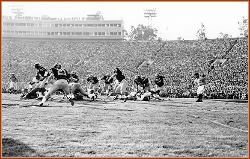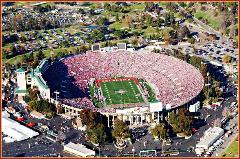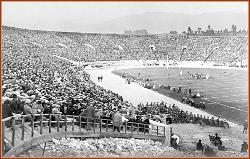Braves Field was a baseball park that formerly stood on Commonwealth Avenue in
Boston, Massachusetts. The stadium was home to the Boston Braves from 1915–
1952, when the team moved to Milwaukee, Wisconsin. Significant portions of the
original structure still stand in place, and make up part of the Nickerson Field sports
complex.
Braves Field was also known as The Bee Hive (or National League Park, formally) from
1936–1941, a period during which the owners changed the nickname of the team to
the Boston Bees (the renaming of the team and stadium never took hold with the
public, and were both eventually dropped). It did host the Major League Baseball All-
Star Game during that span in 1936, however. It was also the home of a National
Football League franchise which began in 1932 and also called itself the Boston
Braves for one year. The next year, the team changed its name to the Redskins and
moved to Fenway Park. In 1937 the team transferred south to become the Washington
Redskins.

The owner of the team at the time the stadium was built, James Gaffney, wanted to see the game played in a wide open field conducive to
allowing numerous inside-the-park home runs. Thus, the stadium was built in what was, at the time, the outskirts of Boston, in a large plot. The
stands were almost entirely in foul territory, leaving little in the outfield to which players could hit a home run into - with the fences over 400
feet away down the lines and nearly 500 feet to dead center, hitting the ball over the outer fences was all but impossible during the "dead ball"
era. A stiff breeze coming in from center field across the Charles River further lessened any chances of seeing home runs fly out of the park.
The only possible target in the outfield was a small bleacher section, which came to be known as The Jury Box after a sportswriter noticed
during one slow mid-week game that there were only twelve individuals sitting in the 2,000-seat stand. Ty Cobb visited the park and
commented, "Nobody will ever hit a ball out of this park."
In fact, it would take 10 years, and a livelier ball, before a batter hit a home run that cleared the outer wall on the fly. Meanwhile, it remained a
pitchers' park, perhaps never more so than on May 1, 1920, when Brooklyn Dodgers pitcher Leon Cadore and Braves pitcher Joe Oeschger
locked horns for a pair of complete-game performances that went on for a still-record 26 innings. After all that work, the game ended in a 1-1
tie, called on account of darkness.
At the advent of the lively ball era, it became clear that the fans were unhappy with Gaffney's vision of how baseball should be played, and
inner fences were built, and regularly moved, being moved in and out based on whims. The ownership of the team even went so far as to shift
the entire field in a clockwise direction (towards right field) at one point.
After the Braves moved to Milwaukee just prior to the 1953 season, the stadium was sold to Boston University. The old ballpark was used
as-is until 1955, when the university reconfigured the stands, demolishing all but the pavilion grandstand along the right field line, which was
retained as the core of a football, soccer, field hockey and track-and-field stadium. The stadium was initially called Boston University Field and
was later renamed Nickerson Field. Aside from the pavilion, parts of the ballpark retained included Gaffney's original outer wall; and the ticket
office, which was converted to the university police station. The rest of the stadium property was replaced by dormitories. Of the various
demolished Jewel Box ballparks, Braves Field probably has the largest proportion of visible remnants still standing.














